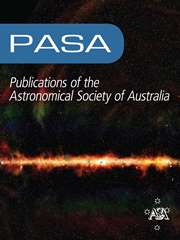No CrossRef data available.
Article contents
On the origin of multifrequency temporal and spectral variability in Ton 599
Published online by Cambridge University Press: 10 April 2025
Abstract
In this work, we studied the broadband temporal and spectral properties of the flat-spectrum radio quasar (FSRQ) Ton 599. We collected the long-term data from January 2019 to August 2024 when the source was in a long flaring episode. We used the Bayesian block methodology to identify the various flux states, including three flares. The broadband fractional variability is estimated during two flaring states. The Fvar variation with respect to frequency shows a nearly double hump structure similar to broadband SED. The Power spectral density (PSD) shows a pink-noise kind of stochastic variability in the light curve, and we do not see any break in the power spectrum, suggesting a much longer characteristic timescale is involved in gamma-ray variability. The flux distribution is well-fitted with a double log-normal flux distribution, suggesting the variability of non-linear in nature. The gamma-ray, optical, and X-ray emissions were found to be highly correlated with a zero time lag, suggesting a co-spatial origin of their emissions. We used the one-zone leptonic model to reproduce the broadband spectrum in the energy range from the IR to very high-energy gamma rays. The increase in the magnetic field and the Doppler factor were found to be the main causes for high flux states. The XMM-Newton spectra taken during one of the flaring durations exhibit a signature of thermal black body emission from the accretion disc, suggesting a possible disc-jet coupling. This has also been indicated by the gamma-ray flux distribution, which shows the distribution as non-linear in nature, which is mostly seen in galactic X-ray binaries or AGN, where the accretion disc dominates the emission.
- Type
- Research Article
- Information
- Creative Commons
- This is an Open Access article, distributed under the terms of the Creative Commons Attribution licence (https://creativecommons.org/licenses/by/4.0/), which permits unrestricted re-use, distribution and reproduction, provided the original article is properly cited.
- Copyright
- © The Author(s), 2025. Published by Cambridge University Press on behalf of Astronomical Society of Australia


